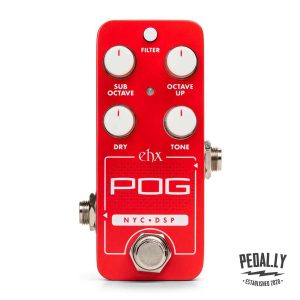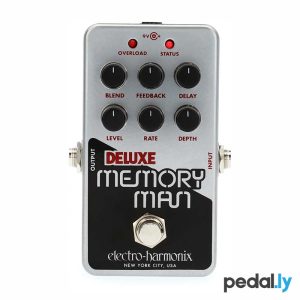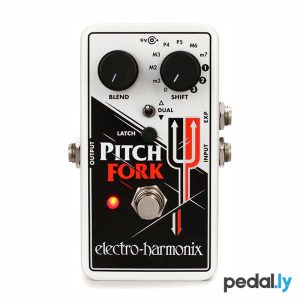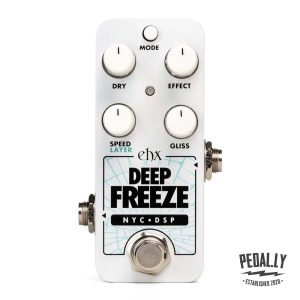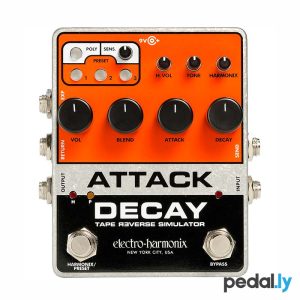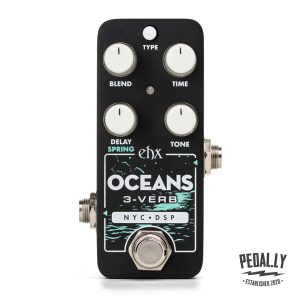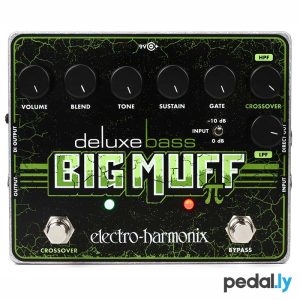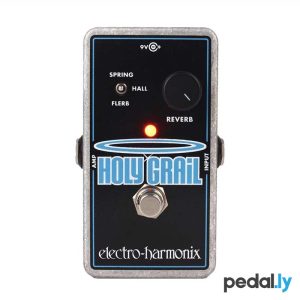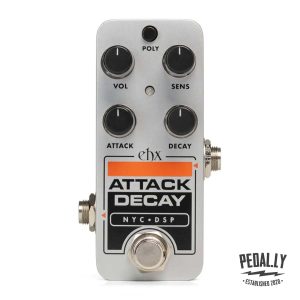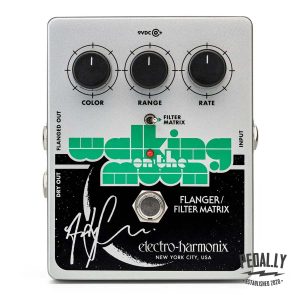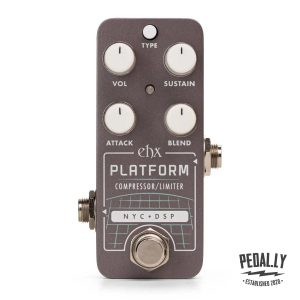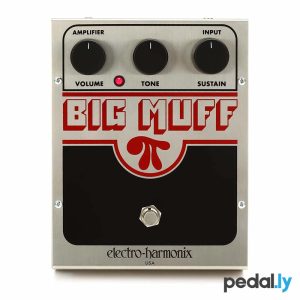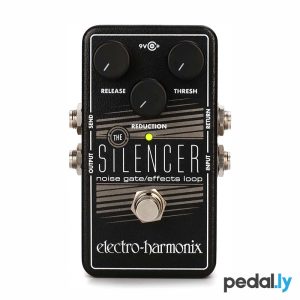Electro-Harmonix Pedals
ELECTRO-HARMONIX PEDALS
-
Electro-Harmonix MEL9 Tape Replay Machine Pedal
$259.50 Add to cart -
Electro-Harmonix Intelligent Harmony Machine Harmony and Pitch Shifter Pedal
$241.50 Add to cart -
Electro-Harmonix Pico POG Octave Pedal
$240.00 Add to cart -
Electro-Harmonix Nano POG Polyphonic Octave Generator Pedal
$230.40 Add to cart -
Electro-Harmonix Nano Deluxe Memory Man Analog Delay/Chorus/Vibrato Pedal
$213.30 Add to cart -
Electro-Harmonix Mainframe Bit Crusher Pedal
$203.20 Add to cart -
Electro-Harmonix Pitch Fork Polyphonic Pitch Shifter Pedal
$197.80 Add to cart -
Electro-Harmonix Pico Deep Freeze Sustainer Pedal
$193.10 Add to cart -
Electro-Harmonix Oceans 11 Reverb Pedal
$176.00 Add to cart -
Electro-Harmonix Attack Decay Tape Reverse Simulator Pedal
$156.00 Add to cart -
Electro-Harmonix Pico Oceans 3-Verb Reverb Pedal
$154.20 Add to cart -
Electro-Harmonix Deluxe Bass Big Muff Pi Bass Fuzz Pedal
$150.69 Add to cart -
Electro-Harmonix Holy Grail Nano Reverb Pedal
$137.90 Add to cart -
Electro-Harmonix Pico Attack Decay Tape Reverse Pedal
$136.90 Add to cart -
Electro-Harmonix J Mascis Ram’s Head Big Muff PI Fuzz Pedal
$131.50 Add to cart -
Electro-Harmonix Andy Summers Walking On The Moon Flanger Pedal
$129.00 Add to cart -
Electro-Harmonix Pico Platform Compressor / Limiter Pedal
$119.00 Add to cart -
Electro-Harmonix Ram’s Head Big Muff Pi Fuzz Pedal
$114.30 Add to cart -
Electro-Harmonix Nano Q-Tron Envelope Controlled Filter Pedal
$111.70 Add to cart -
Electro-Harmonix Green Russian Big Muff Pi Fuzz Pedal
$108.90 Add to cart -
Electro-Harmonix Big Muff Pi (Classic) Fuzz Pedal
$101.60 Add to cart -
Electro-Harmonix Lizard Queen Octave Fuzz Pedal
$99.00 Add to cart -
Electro-Harmonix Op-Amp Big Muff Fuzz Pedal
$96.20 Add to cart -
Electro-Harmonix Soul Food Distortion/Overdrive Pedal
$89.00 Add to cart -
Electro-Harmonix Nano Big Muff Pi Fuzz Pedal
$87.10 Add to cart -
Electro-Harmonix The Silencer Noise Gate / Effects Loop Pedal
$80.70 Add to cart -
Electro-Harmonix Satisfaction Fuzz Pedal
$69.10 Add to cart
The History of Electro-Harmonix
Electro-Harmonix is a pioneering company in the field of guitar effects pedals. Founded in New York City in 1968 by a man named Mike Matthews, the company’s “Electro-Harmonix” name was derived from the terms “Electro” referring to electronic circuits and “Harmonix” referring to the musical intervals. Mike is considered the Godfather of effects pedals.
In the late 1960s and early 1970s, Electro-Harmonix gained popularity by producing innovative and unique effects pedals such as the Big Muff Pi fuzz pedal, the Electric Mistress flanger, and the Memory Man delay pedal. These pedals were used by famous guitarists such as Jimi Hendrix, David Gilmour, and Eddie Van Halen.
The company faced financial difficulties in the mid-1980s and was eventually sold to a company called New Sensor Corporation in the early 1990s. However, Electro-Harmonix continued to produce quality effects pedals, and its popularity continued to grow.
In recent years, Electro-Harmonix has expanded its product line to include a wide variety of pedals, amplifiers, and accessories, catering not only to guitarists but also to bass players, keyboardists, and other musicians.
Many of the original Electro-Harmonix pedals have been refactored into “nano” versions of the pedals. The Nano Big Muff Pi fuzz pedal is a perfect example of taking a classic large format pedal and putting it into a smaller modern pedal enclosure.
The EHX company remains a major player in the world of effects pedals and continues to be a popular choice among musicians around the world.
The Popularity of Electro-Harmonix
Guitarists like Electro-Harmonix pedals for several reasons.
Here is why Electro-Harmonix pedals remain so desired:
Unique sounds: Electro-Harmonix pedals are known for their distinctive and unique sounds. They often produce effects that are difficult to replicate with other pedals or effects processors, which can inspire creativity and spark new ideas for guitarists.
High-quality construction: Electro-Harmonix pedals are generally well-built and sturdy, which makes them reliable for live performances and studio recording.
Versatility: Electro-Harmonix produces a wide variety of pedals, ranging from classic fuzz and distortion to more experimental and innovative effects. This means that guitarists can find pedals that suit their specific needs and playing styles.
Affordable: While some high-end boutique pedals can be quite expensive, many of Electro-Harmonix’s pedals are relatively affordable, which makes them accessible to a wide range of guitarists.
Reputation: Electro-Harmonix has been producing quality pedals for over 50 years, and many famous guitarists have used their pedals. This gives them a reputation for quality and reliability among guitarists.
Electro-Harmonix in the Recording Studio
There are many famous songs that use Electro-Harmonix pedals. Here are a few examples:
“Voodoo Child (Slight Return)” by Jimi Hendrix: This classic song features Hendrix’s use of the Electro-Harmonix Big Muff Pi fuzz pedal, which gives the guitar a thick, distorted sound.
“Come As You Are” by Nirvana: Kurt Cobain used the Electro-Harmonix Small Clone chorus pedal on the iconic riff in this song, which gives it a distinctive, watery sound.
“Money” by Pink Floyd: David Gilmour used the Electro-Harmonix Electric Mistress flanger pedal on the guitar solo in this song, which gives it a swirling, psychedelic sound.
“Bulls on Parade” by Rage Against the Machine: Tom Morello used the Electro-Harmonix Q-Tron envelope filter pedal on the guitar riff in this song, which gives it a funky, wah-wah-like sound.
“Mr. Brightside” by The Killers: The guitar riff in this song features the Electro-Harmonix Holy Grail reverb pedal, which gives it a spacious, atmospheric sound.
These are just a few examples of the many songs that use Electro-Harmonix pedals. Many famous guitarists have used these pedals in their music, and they have become a staple of the guitar effects world.



